Abstract
Geospatial technology has become a great tool for epidemiology study because, with this technological advance,we can determine the environment in which transmission occurs, the distribution of the disease and its evolution over time. One of the important diseases related to public health in Bolivia is the chikungunya disease, also known as chikungunya fever. Therefore, the present research aims to analyze an area of Bolivia with a high number of cases of chikungunya based on remote sensing and GIS. Environmental parameters extracted from Landsat 8 satellite image, together with meteorological data extracted from the National Service of Meteorology in Bolivia, and the epidemiological information of chikungunya cases extracted from the Ministry of Health were the data sources included in this study. A principal component analysis of all the parameters obtained will be developed to build the relationship between the environmental parameters and chikungunya outbreaks in certain months of the year. We construct a GIS platform to allow the end user visualize and interact with the different layers. This study will allow us to have a more integrated understanding of this disease, understand the environment in which the transmission happens, identify in which months higher outbreaks occur and the climatic conditions under which it occurs. This will give us new potential to prevent and control this emerging disease in Bolivia.

















Similar content being viewed by others
References
Maguiña-Vargas C (2015) Fiebre de Chikungunya: Una nueva enfermedad emergente de gran impacto en la salud pública. Revista Médica Herediana 26(1):55–59
Pialoux G, Gaüzère BA, Jauréguiberry S, Strobel M (2007) Chikungunya, an epidemic arbovirosis. Lancet Infect Dis 7(5):319–327
Wu X, Lu Y, Zhou S, Chen L, Xu B (2016) Impact of climate change on human infectious diseases: empirical evidence and human adaptation. Environ Int 86:14–23
Yactayo S, Staples JE, Millot V, Cibrelus L, Ramon-Pardo P (2016) Epidemiology of chikungunya in the Americas. J Infect Dis 214(Suppl_5):S441–S445
Pan American Health Organization. Number of reported cases of CHIK fever in the Americas by country or territory 2014-2016, and 2017 [EB/OL]. http://www.paho.org/hq/index.php?option=com_topics&view=readall&cid=5927&Itemid=40931&lang=en. Accessed 2 Dec 2017
Finger F, Knox A, Bertuzzo E, Mari L, Bompangue D, Gatto M, Rinaldo A (2014) Cholera in the Lake Kivu region (DRC): integrating remote sensing and spatially explicit epidemiological modeling. Water Resour Res 50(7):5624–5637
Machault V, Yébakima A, Etienne M, Vignolles C, Palany P, Tourre YM, Lacaux JP (2014) Mapping entomological dengue risk levels in Martinique using high-resolution remote-sensing environmental data. ISPRS Int J Geoinf 3(4):1352–1371
Sewe MO, Tozan Y, Ahlm C, Rocklöv J (2017) Using remote sensing environmental data to forecast malaria incidence at a rural district hospital in Western Kenya. Sci Rep 7(1):2589
Centers for Disease Control and Prevention. Geographic Distribution Chikungunya Virus [EB/OL]. https://www.cdc.gov/chikungunya/geo/index.html. Accessed 6 Nov 2017
Leparc-Goffart I, Nougairede A, Cassadou S, Prat C, de Lamballerie X (2014) Chikungunya in the Americas. Lancet 383:514
Ministry of Health of Bolivia. Programa Nacional de Prevención y Control de Dengue, Chikungunya y Zika: Situación epidemiológica Semana 1-22, 2016 [R]. 2017
Irons JR, Dwyer JL, Barsi JA (2012) The next Landsat satellite: the Landsat data continuity mission. Remote Sens Environ 122:11–21
Deng Y, Wu C, Li M, Chen R (2015) RNDSI: a ratio normalized difference soil index for remote sensing of urban/suburban environments. Int J Appl Earth Obs Geoinf 39:40–48
Gu Y, Hunt E, Wardlow B, Basara JB, Brown JF, Verdin JP (2008) Evaluation of MODIS NDVI and NDWI for vegetation drought monitoring using Oklahoma Mesonet soil moisture data. Geophys Res Lett 35(22)
Zha Y, Gao J, Ni S (2003) Use of normalized difference builtup index in automatically mapping urban areas from TM imagery. Int J Remote Sens 24(3):583–594
Weng Q (2010) Remote sensing and GIS integration. Theories, methods and applications. McGraw-Hills, New York
Bro R, Smilde AK (2014) Principal components analysis. Anal Methods 6(9):2812–2831
Acknowledgements
I want to acknowledge Beihang University and the Image Processing Research Laboratory (INTI-Lab) of the Universidad de Ciencias y Humanidades (UCH).
Author information
Authors and Affiliations
Corresponding author
Rights and permissions
About this article
Cite this article
Vargas-Cuentas, N.I., Roman-Gonzalez, A. & Yumin, T. Spatial–Temporal Epidemiology Study of Chikungunya Disease in Bolivia. Adv. Astronaut. Sci. Technol. 1, 69–80 (2018). https://doi.org/10.1007/s42423-018-0014-4
Received:
Revised:
Accepted:
Published:
Issue Date:
DOI: https://doi.org/10.1007/s42423-018-0014-4




